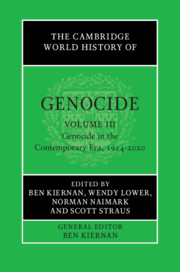Book contents
- The Cambridge World History of Genocide
- The Cambridge World History of Genocide
- The Cambridge World History of Genocide
- Copyright page
- Contents
- Figures
- Tables
- Maps
- Contributors to Volume III
- Introduction to Volume III
- Part I Racism, Total War, Imperial Collapse and Revolution
- 1 Prelude to Genocide
- 2 War and Genocide in the Twentieth Century
- 3 The Armenian Genocide
- 4 Australia’s Stolen Generations, 1914–2021
- 5 Eurocentrism, Silence and Memory of Genocide in Colonial Libya, 1929–1934
- 6 Spain 1936–1945
- 7 Genocide in Stalinist Russia and Ukraine, 1930–1938
- 8 The Famine in Soviet Kazakhstan
- Part II World War Two
- Part III The Nation-State System during the Cold War
- Part IV Globalisation and Genocide since the Cold War
- Index
8 - The Famine in Soviet Kazakhstan
from Part I - Racism, Total War, Imperial Collapse and Revolution
Published online by Cambridge University Press: 23 June 2023
- The Cambridge World History of Genocide
- The Cambridge World History of Genocide
- The Cambridge World History of Genocide
- Copyright page
- Contents
- Figures
- Tables
- Maps
- Contributors to Volume III
- Introduction to Volume III
- Part I Racism, Total War, Imperial Collapse and Revolution
- 1 Prelude to Genocide
- 2 War and Genocide in the Twentieth Century
- 3 The Armenian Genocide
- 4 Australia’s Stolen Generations, 1914–2021
- 5 Eurocentrism, Silence and Memory of Genocide in Colonial Libya, 1929–1934
- 6 Spain 1936–1945
- 7 Genocide in Stalinist Russia and Ukraine, 1930–1938
- 8 The Famine in Soviet Kazakhstan
- Part II World War Two
- Part III The Nation-State System during the Cold War
- Part IV Globalisation and Genocide since the Cold War
- Index
Summary
The Kazakh famine of 1930–3 ranks as one of the great crimes of the Stalinist regime. The crisis, which was sparked by Josef Stalin’s programme of forced collectivisation, led to the death of roughly a third of all Kazakhs, believed to be the highest death ratio due to collectivisation of any people in the Soviet Union. More than 1.5 million people perished, of the total population of around 6 million living in the Kazakh Autonomous Soviet Socialist Republic (the Kazakh ASSR, often known as Kazakhstan). Kazakhs, who speak their own Turkic language, became a minority in their own republic. They would not again constitute more than 50 per cent of the population in Kazakhstan until after the Soviet collapse. The Kazakh famine also constitutes one of the largest pastoral famines in modern history. Prior to the crisis, most Kazakhs practiced pastoral nomadism, carrying out seasonal migrations to pasture their animal herds. But those who survived were forced to settle, prompting a painful and far-reaching reorientation of Kazakh culture and identity.
- Type
- Chapter
- Information
- The Cambridge World History of Genocide , pp. 186 - 208Publisher: Cambridge University PressPrint publication year: 2023



